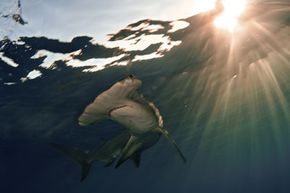Key Takeaways
- Hammerhead sharks have a unique head shape that enhances their sensory abilities and helps them pin down prey like stingrays.
- The great hammerhead is the largest species, growing up to 18 feet (5.5 meters) long and weighing up to 800 pounds (363 kg).
- Scalloped hammerheads exhibit schooling behavior, unlike most other sharks, and this social structure is thought to help with mating and protection.
Great white sharks certainly don't suffer from a lack of self-esteem. After all, they're the No. 1 predator in the sea. Tiger and bull sharks aren't too shabby either -- they're stealth hunters that look great on television and scare the daylights out of beachcombers. White tips and threshers look pretty tough, too, even though they aren't as feared as their great white and bullish cousins. Hammerheads, on the other hand, might feel a little left out. They have little mouths with little teeth, and they aren't known to bother humans much. They don't exactly strike fear into the hearts of scuba divers or surfers. Then there's the head. The wide, flat, hammer-shaped head with bug eyes on either side -- they're just kind of funny-looking.
Advertisement
Despite how they may feel about themselves, hammerheads are one of the most intriguing species of shark. There are nine different classifications of hammerhead sharks, but only four are common and abundant: the great hammerhead, scalloped hammerhead, smooth hammerhead and bonnethead. Out of these four, all but the bonnethead are considered to be dangerous to humans, but you probably shouldn't worry much about them. There have only been 38 recorded hammerhead attacks on humans since 1580, only 16 of which were unprovoked, and no one has ever been killed by a hammerhead [source: ISAF]. They aren't generally aggressive toward people, so the unprovoked attacks were likely due to surprise or fear.
You can find hammerheads in temperate and tropical waters all over the world. Some, (like the great hammerhead), stay in deeper waters, while other species hang out closer to the shore. They like cooler water and will migrate in schools toward the poles in the warm summer months. They're fished commercially and recreationally for their hides and meat, and like most sharks, their fins are commonly cut off in a process called finning and used as an ingredient in shark fin soup in Asia. Shark finning is condemned as cruel throughout much of the world and is outlawed in U.S. waters.
We'll get into the unusual physical characteristics of the hammerhead shark in this article and explore the different theories about what their odd-shaped head is used for. We'll also learn about their mating habits, how they hunt, what they eat and which ones travel in schools.
Advertisement


